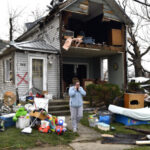Swiss Re has just released its latest sigma study, which details the toll of disasters that made 2008 “one of the worst years for catastrophe losses” according to the report.
More than 240,500 people lost their lives, while the insurance industry paid out $52.5 billion “to compensate for property claims.” Swiss Re put the total “impact on the economy caused by natural and man-made catastrophes around the world” at up to $269 billion.
“2008 was exceptional in terms of fatalities and losses,” said Swiss Re. “Statistics confirm a trend towards an increase in the number and costs of natural catastrophes and man-made disasters.”
The sigma study concluded that “natural catastrophes and man-made disasters in 2008″, 137 natural catastrophes and 174 man-made disasters occurred in 2008. Asia suffered the most in terms of the number of lives lost, while the US was worst hit in regard to insured property losses. Europe was less impacted with only minor losses compared to last year.”
Natural catastrophes cost property insurers more than $44.7 billion. The most costly events were Hurricanes Ike and Gustav as well as thunderstorms during the first half of 2008. Europe’s losses, however, were “down from last year, represented slightly more than a tenth of the world total in 2008, largely due to lower storm and flood damages.”
In addition Swiss Re noted that “China suffered losses amounting to more than $1.3 billion, driven by an unusually cold winter with record amounts of ice and snow.”
“Man Made” catastrophes accounted for more than $7.8 billion. These included “large-scale industrial fires, explosions and losses in the energy sector at the top of the list. Man-made catastrophes resulted in 5,600 deaths in 2008; shipping and boating accidents as well as bombings and social unrest caused the most casualties.”
The study also pointed out that “losses in Asia were “extremely high,” and were “likely to spur a need for insurance.”
Total damages to the global economy in 2008 “amounted to $269 billion. Half of that figure “can be attributed to the earthquake that struck China in May, which caused costs to the economy of $124 billion, which is approximately 3 percent of China’s GDP.”
Swiss Re also explained that “many governments in Asia face significant financial risks when catastrophes occur. Given the rapid development of income and wealth in Asia, the financial exposures will swiftly rise. This is likely to increase the focus on prevention and ex-post disaster management. It will also give rise to the development of insurance as a tool to cope with the financial consequences of catastrophes.
“It is expected therefore, that in Asia, insurance will play a more important role in the future than it does today. Nevertheless, such development needs time. Given the high percentage of people with low incomes in this part of the world, public private partnerships are critical to the development of effective and accessible insurance solutions. Global and regional insurers and reinsurers also play an essential part in the further establishment of insurance in Asia, on the one hand by sharing their knowledge and expertise, and on the other by helping to absorb the rising risks in these markets.”
The full bulletin, which includes graphs and tables with further details, may be obtained on Swiss Re’s web site at: www.swissre.com
To obtain a copy of sigma study No 2/2009 – “Natural catastrophes and man-made disasters in 2008: North America and Asia suffer heavy losses,” which is available in English, German, French, Italian and Spanish versions, go to:
www.swissre.com/sigma. The versions in Chinese and Japanese will appear in the near future.
Source: Swiss Re
Was this article valuable?
Here are more articles you may enjoy.

 CoreLogic Report Probes Evolving Severe Convective Storm Risk Landscape
CoreLogic Report Probes Evolving Severe Convective Storm Risk Landscape  EVs Head for Junkyard as Mechanic Shortage Inflates Repair Costs
EVs Head for Junkyard as Mechanic Shortage Inflates Repair Costs  Gallagher: Global Insured Natural Disaster Claims Again Dominated by Severe U.S. Storms
Gallagher: Global Insured Natural Disaster Claims Again Dominated by Severe U.S. Storms  Viewpoint: The Impact of Behavioral Health on Workers’ Comp
Viewpoint: The Impact of Behavioral Health on Workers’ Comp 